Deviance, Difference & Conformity: A Sociological Analysis of A3 Essay
VerifiedAdded on 2020/02/24
|8
|2308
|171
Essay
AI Summary
This essay delves into the multifaceted concept of deviance within sociology, exploring its significance and various theoretical underpinnings. It begins by defining deviance as behavior contrary to societal norms and discusses its prominence in sociological discussions. The essay examines several key theories, including Merton's strain theory, labeling theory, social control theory, and differential association theory, highlighting how these frameworks contribute to understanding deviance. It also explores Durkheim's perspective on deviance, emphasizing its role in maintaining social order and solidarity, while also discussing the evolution from mechanical to organic solidarity. The essay further investigates the contextual nature of deviance, emphasizing that what is considered deviant varies across contexts and cultures. It then analyzes the arguments regarding the 'death' and 'resurrection' of the sociology of deviance, providing evidence from various scholars to support the continued relevance of the field. Finally, the essay concludes by summarizing the key arguments and reiterating the ongoing importance of studying deviance in understanding social dynamics and human behavior.
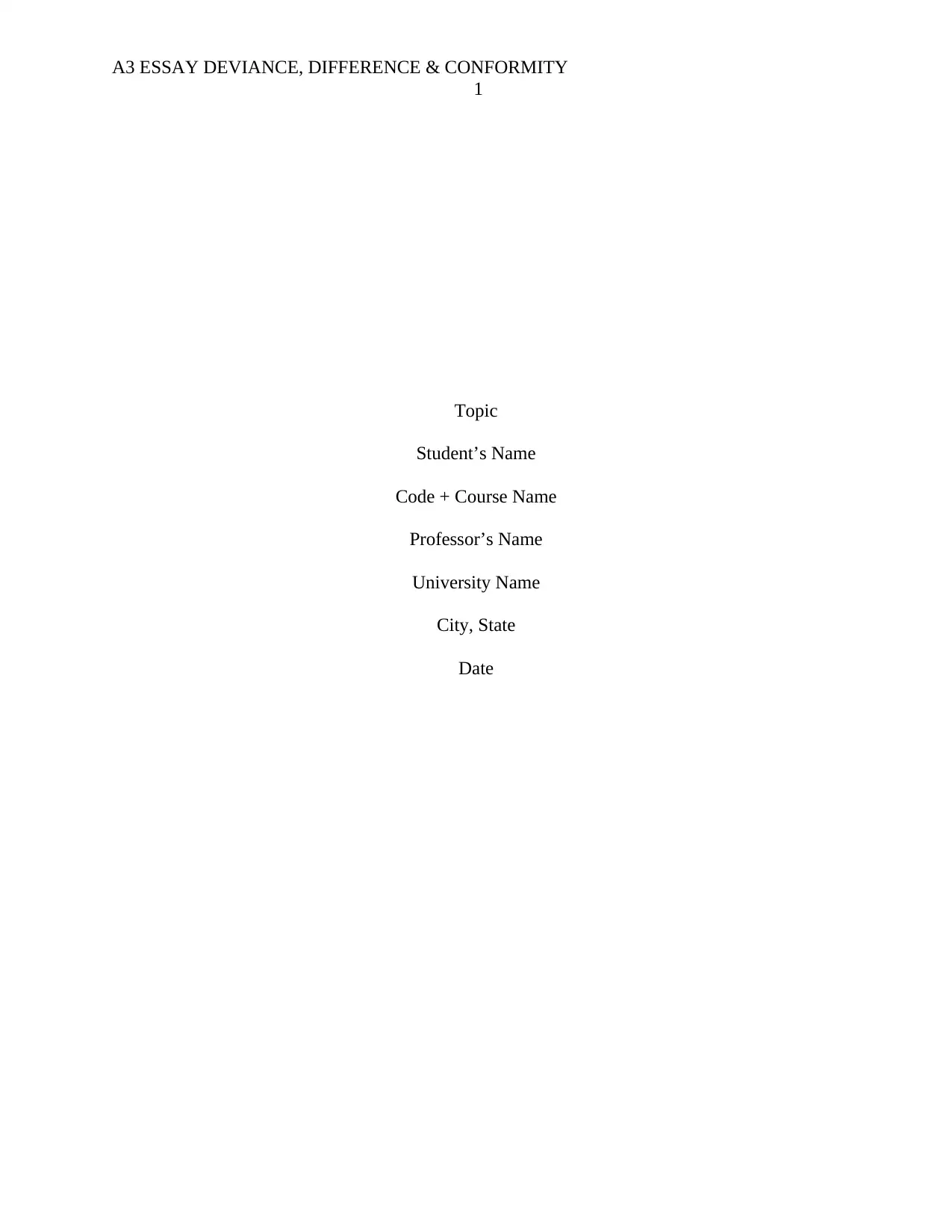
A3 ESSAY DEVIANCE, DIFFERENCE & CONFORMITY
1
Topic
Student’s Name
Code + Course Name
Professor’s Name
University Name
City, State
Date
1
Topic
Student’s Name
Code + Course Name
Professor’s Name
University Name
City, State
Date
Paraphrase This Document
Need a fresh take? Get an instant paraphrase of this document with our AI Paraphraser
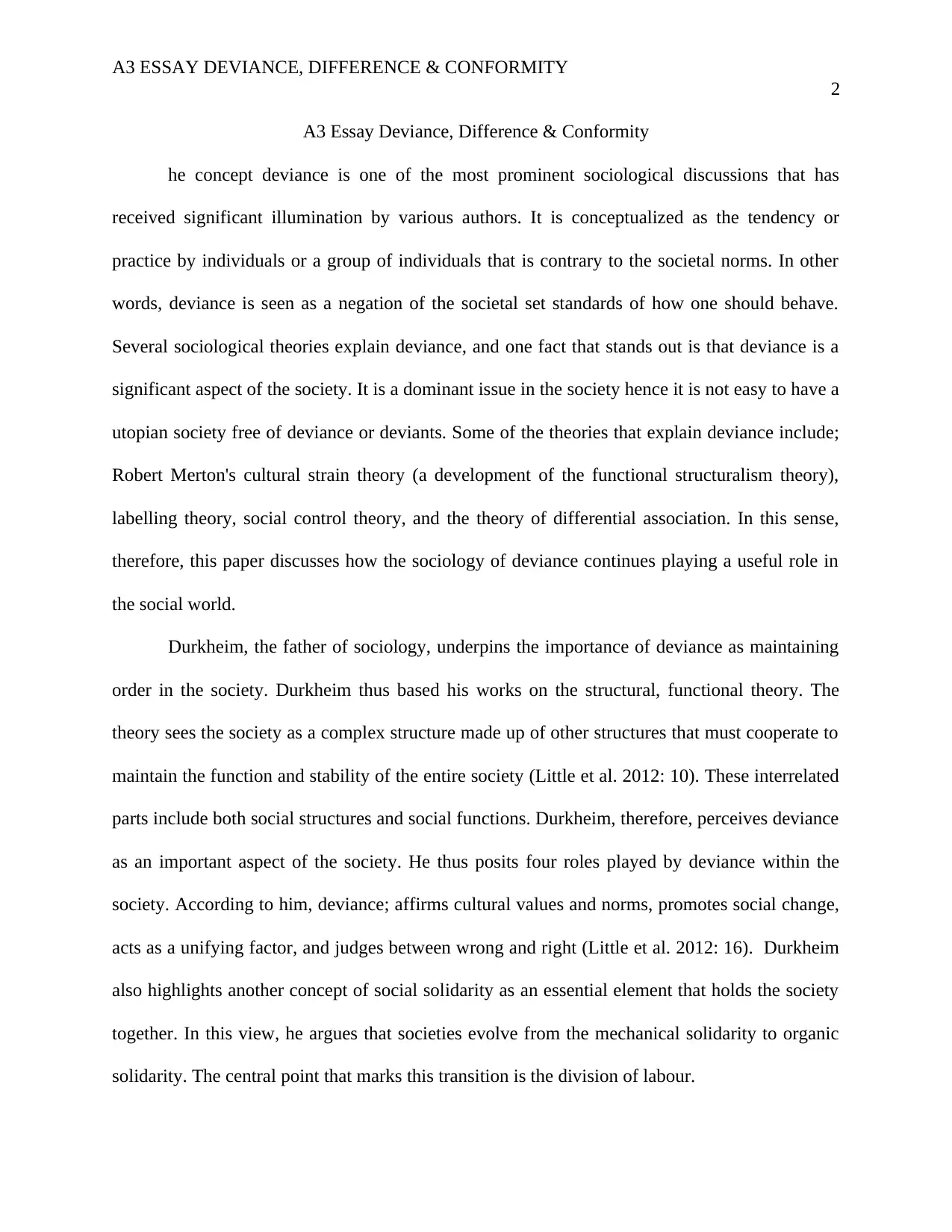
A3 ESSAY DEVIANCE, DIFFERENCE & CONFORMITY
2
A3 Essay Deviance, Difference & Conformity
he concept deviance is one of the most prominent sociological discussions that has
received significant illumination by various authors. It is conceptualized as the tendency or
practice by individuals or a group of individuals that is contrary to the societal norms. In other
words, deviance is seen as a negation of the societal set standards of how one should behave.
Several sociological theories explain deviance, and one fact that stands out is that deviance is a
significant aspect of the society. It is a dominant issue in the society hence it is not easy to have a
utopian society free of deviance or deviants. Some of the theories that explain deviance include;
Robert Merton's cultural strain theory (a development of the functional structuralism theory),
labelling theory, social control theory, and the theory of differential association. In this sense,
therefore, this paper discusses how the sociology of deviance continues playing a useful role in
the social world.
Durkheim, the father of sociology, underpins the importance of deviance as maintaining
order in the society. Durkheim thus based his works on the structural, functional theory. The
theory sees the society as a complex structure made up of other structures that must cooperate to
maintain the function and stability of the entire society (Little et al. 2012: 10). These interrelated
parts include both social structures and social functions. Durkheim, therefore, perceives deviance
as an important aspect of the society. He thus posits four roles played by deviance within the
society. According to him, deviance; affirms cultural values and norms, promotes social change,
acts as a unifying factor, and judges between wrong and right (Little et al. 2012: 16). Durkheim
also highlights another concept of social solidarity as an essential element that holds the society
together. In this view, he argues that societies evolve from the mechanical solidarity to organic
solidarity. The central point that marks this transition is the division of labour.
2
A3 Essay Deviance, Difference & Conformity
he concept deviance is one of the most prominent sociological discussions that has
received significant illumination by various authors. It is conceptualized as the tendency or
practice by individuals or a group of individuals that is contrary to the societal norms. In other
words, deviance is seen as a negation of the societal set standards of how one should behave.
Several sociological theories explain deviance, and one fact that stands out is that deviance is a
significant aspect of the society. It is a dominant issue in the society hence it is not easy to have a
utopian society free of deviance or deviants. Some of the theories that explain deviance include;
Robert Merton's cultural strain theory (a development of the functional structuralism theory),
labelling theory, social control theory, and the theory of differential association. In this sense,
therefore, this paper discusses how the sociology of deviance continues playing a useful role in
the social world.
Durkheim, the father of sociology, underpins the importance of deviance as maintaining
order in the society. Durkheim thus based his works on the structural, functional theory. The
theory sees the society as a complex structure made up of other structures that must cooperate to
maintain the function and stability of the entire society (Little et al. 2012: 10). These interrelated
parts include both social structures and social functions. Durkheim, therefore, perceives deviance
as an important aspect of the society. He thus posits four roles played by deviance within the
society. According to him, deviance; affirms cultural values and norms, promotes social change,
acts as a unifying factor, and judges between wrong and right (Little et al. 2012: 16). Durkheim
also highlights another concept of social solidarity as an essential element that holds the society
together. In this view, he argues that societies evolve from the mechanical solidarity to organic
solidarity. The central point that marks this transition is the division of labour.
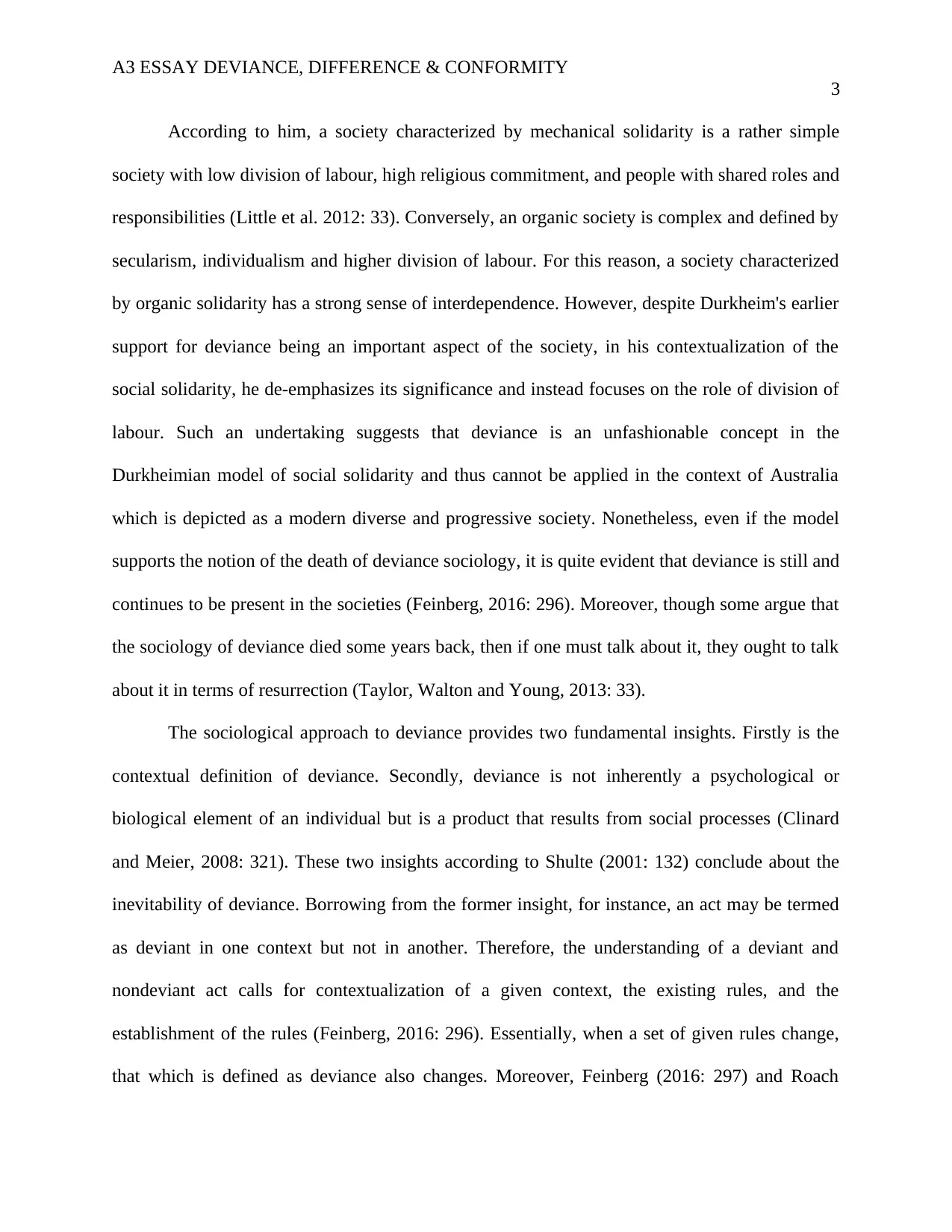
A3 ESSAY DEVIANCE, DIFFERENCE & CONFORMITY
3
According to him, a society characterized by mechanical solidarity is a rather simple
society with low division of labour, high religious commitment, and people with shared roles and
responsibilities (Little et al. 2012: 33). Conversely, an organic society is complex and defined by
secularism, individualism and higher division of labour. For this reason, a society characterized
by organic solidarity has a strong sense of interdependence. However, despite Durkheim's earlier
support for deviance being an important aspect of the society, in his contextualization of the
social solidarity, he de-emphasizes its significance and instead focuses on the role of division of
labour. Such an undertaking suggests that deviance is an unfashionable concept in the
Durkheimian model of social solidarity and thus cannot be applied in the context of Australia
which is depicted as a modern diverse and progressive society. Nonetheless, even if the model
supports the notion of the death of deviance sociology, it is quite evident that deviance is still and
continues to be present in the societies (Feinberg, 2016: 296). Moreover, though some argue that
the sociology of deviance died some years back, then if one must talk about it, they ought to talk
about it in terms of resurrection (Taylor, Walton and Young, 2013: 33).
The sociological approach to deviance provides two fundamental insights. Firstly is the
contextual definition of deviance. Secondly, deviance is not inherently a psychological or
biological element of an individual but is a product that results from social processes (Clinard
and Meier, 2008: 321). These two insights according to Shulte (2001: 132) conclude about the
inevitability of deviance. Borrowing from the former insight, for instance, an act may be termed
as deviant in one context but not in another. Therefore, the understanding of a deviant and
nondeviant act calls for contextualization of a given context, the existing rules, and the
establishment of the rules (Feinberg, 2016: 296). Essentially, when a set of given rules change,
that which is defined as deviance also changes. Moreover, Feinberg (2016: 297) and Roach
3
According to him, a society characterized by mechanical solidarity is a rather simple
society with low division of labour, high religious commitment, and people with shared roles and
responsibilities (Little et al. 2012: 33). Conversely, an organic society is complex and defined by
secularism, individualism and higher division of labour. For this reason, a society characterized
by organic solidarity has a strong sense of interdependence. However, despite Durkheim's earlier
support for deviance being an important aspect of the society, in his contextualization of the
social solidarity, he de-emphasizes its significance and instead focuses on the role of division of
labour. Such an undertaking suggests that deviance is an unfashionable concept in the
Durkheimian model of social solidarity and thus cannot be applied in the context of Australia
which is depicted as a modern diverse and progressive society. Nonetheless, even if the model
supports the notion of the death of deviance sociology, it is quite evident that deviance is still and
continues to be present in the societies (Feinberg, 2016: 296). Moreover, though some argue that
the sociology of deviance died some years back, then if one must talk about it, they ought to talk
about it in terms of resurrection (Taylor, Walton and Young, 2013: 33).
The sociological approach to deviance provides two fundamental insights. Firstly is the
contextual definition of deviance. Secondly, deviance is not inherently a psychological or
biological element of an individual but is a product that results from social processes (Clinard
and Meier, 2008: 321). These two insights according to Shulte (2001: 132) conclude about the
inevitability of deviance. Borrowing from the former insight, for instance, an act may be termed
as deviant in one context but not in another. Therefore, the understanding of a deviant and
nondeviant act calls for contextualization of a given context, the existing rules, and the
establishment of the rules (Feinberg, 2016: 296). Essentially, when a set of given rules change,
that which is defined as deviance also changes. Moreover, Feinberg (2016: 297) and Roach
⊘ This is a preview!⊘
Do you want full access?
Subscribe today to unlock all pages.

Trusted by 1+ million students worldwide
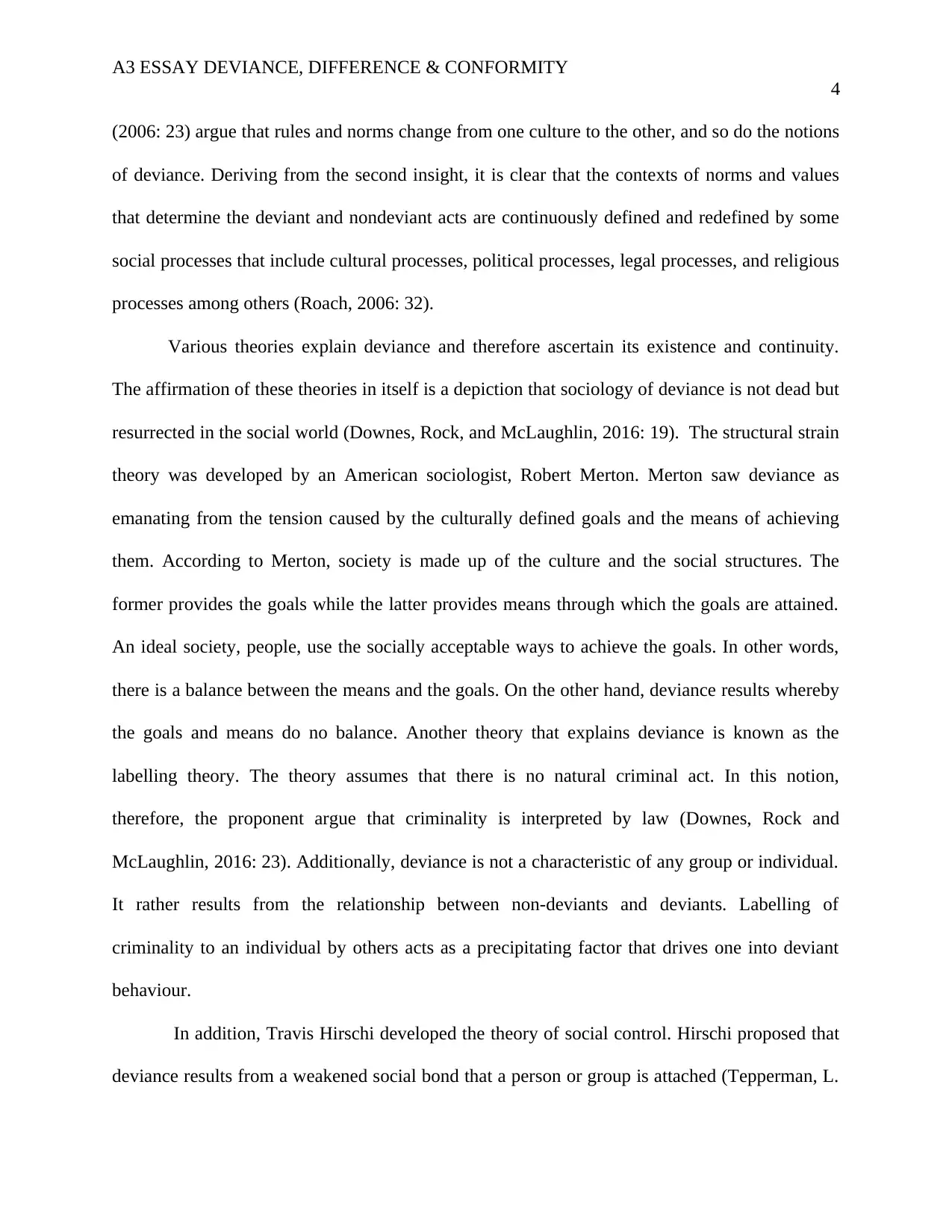
A3 ESSAY DEVIANCE, DIFFERENCE & CONFORMITY
4
(2006: 23) argue that rules and norms change from one culture to the other, and so do the notions
of deviance. Deriving from the second insight, it is clear that the contexts of norms and values
that determine the deviant and nondeviant acts are continuously defined and redefined by some
social processes that include cultural processes, political processes, legal processes, and religious
processes among others (Roach, 2006: 32).
Various theories explain deviance and therefore ascertain its existence and continuity.
The affirmation of these theories in itself is a depiction that sociology of deviance is not dead but
resurrected in the social world (Downes, Rock, and McLaughlin, 2016: 19). The structural strain
theory was developed by an American sociologist, Robert Merton. Merton saw deviance as
emanating from the tension caused by the culturally defined goals and the means of achieving
them. According to Merton, society is made up of the culture and the social structures. The
former provides the goals while the latter provides means through which the goals are attained.
An ideal society, people, use the socially acceptable ways to achieve the goals. In other words,
there is a balance between the means and the goals. On the other hand, deviance results whereby
the goals and means do no balance. Another theory that explains deviance is known as the
labelling theory. The theory assumes that there is no natural criminal act. In this notion,
therefore, the proponent argue that criminality is interpreted by law (Downes, Rock and
McLaughlin, 2016: 23). Additionally, deviance is not a characteristic of any group or individual.
It rather results from the relationship between non-deviants and deviants. Labelling of
criminality to an individual by others acts as a precipitating factor that drives one into deviant
behaviour.
In addition, Travis Hirschi developed the theory of social control. Hirschi proposed that
deviance results from a weakened social bond that a person or group is attached (Tepperman, L.
4
(2006: 23) argue that rules and norms change from one culture to the other, and so do the notions
of deviance. Deriving from the second insight, it is clear that the contexts of norms and values
that determine the deviant and nondeviant acts are continuously defined and redefined by some
social processes that include cultural processes, political processes, legal processes, and religious
processes among others (Roach, 2006: 32).
Various theories explain deviance and therefore ascertain its existence and continuity.
The affirmation of these theories in itself is a depiction that sociology of deviance is not dead but
resurrected in the social world (Downes, Rock, and McLaughlin, 2016: 19). The structural strain
theory was developed by an American sociologist, Robert Merton. Merton saw deviance as
emanating from the tension caused by the culturally defined goals and the means of achieving
them. According to Merton, society is made up of the culture and the social structures. The
former provides the goals while the latter provides means through which the goals are attained.
An ideal society, people, use the socially acceptable ways to achieve the goals. In other words,
there is a balance between the means and the goals. On the other hand, deviance results whereby
the goals and means do no balance. Another theory that explains deviance is known as the
labelling theory. The theory assumes that there is no natural criminal act. In this notion,
therefore, the proponent argue that criminality is interpreted by law (Downes, Rock and
McLaughlin, 2016: 23). Additionally, deviance is not a characteristic of any group or individual.
It rather results from the relationship between non-deviants and deviants. Labelling of
criminality to an individual by others acts as a precipitating factor that drives one into deviant
behaviour.
In addition, Travis Hirschi developed the theory of social control. Hirschi proposed that
deviance results from a weakened social bond that a person or group is attached (Tepperman, L.
Paraphrase This Document
Need a fresh take? Get an instant paraphrase of this document with our AI Paraphraser
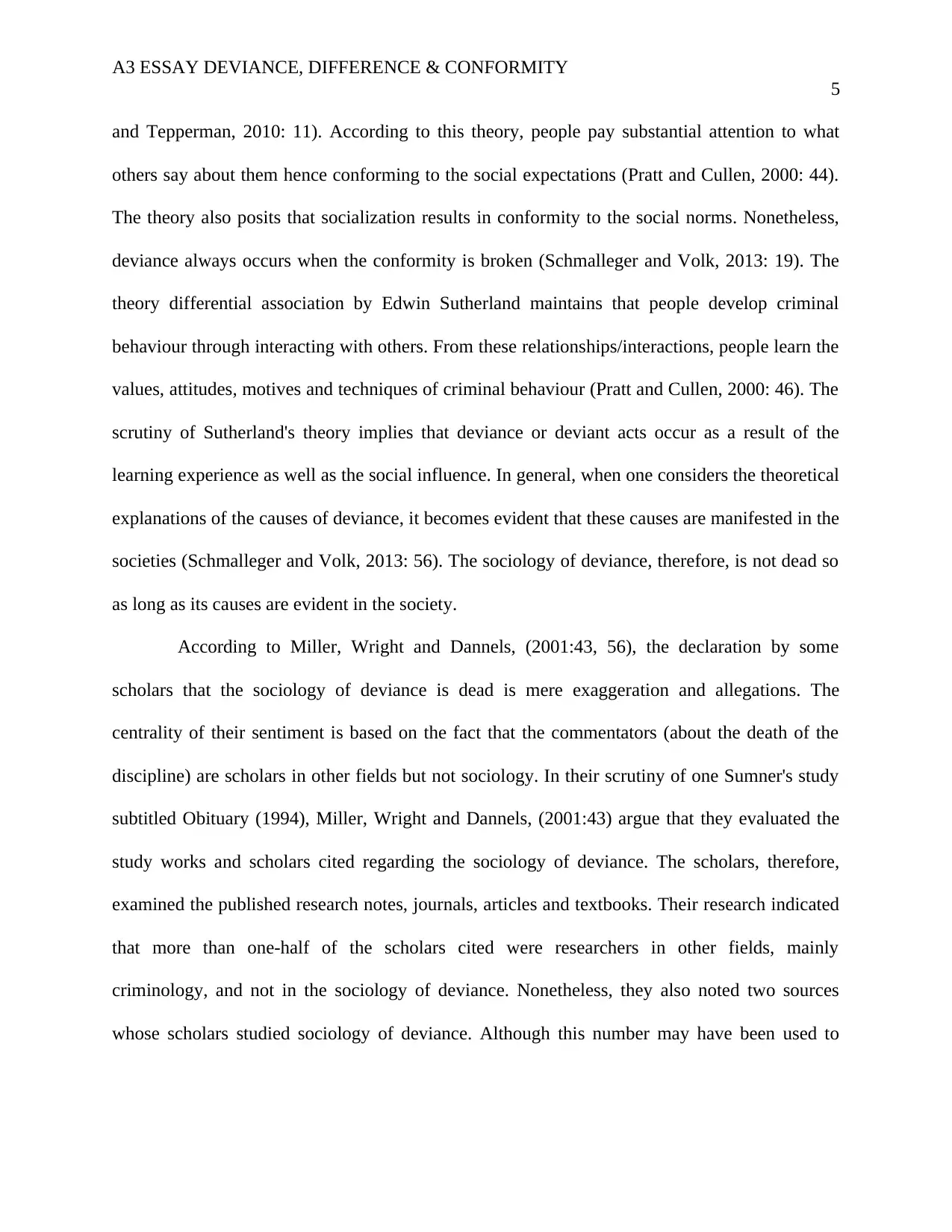
A3 ESSAY DEVIANCE, DIFFERENCE & CONFORMITY
5
and Tepperman, 2010: 11). According to this theory, people pay substantial attention to what
others say about them hence conforming to the social expectations (Pratt and Cullen, 2000: 44).
The theory also posits that socialization results in conformity to the social norms. Nonetheless,
deviance always occurs when the conformity is broken (Schmalleger and Volk, 2013: 19). The
theory differential association by Edwin Sutherland maintains that people develop criminal
behaviour through interacting with others. From these relationships/interactions, people learn the
values, attitudes, motives and techniques of criminal behaviour (Pratt and Cullen, 2000: 46). The
scrutiny of Sutherland's theory implies that deviance or deviant acts occur as a result of the
learning experience as well as the social influence. In general, when one considers the theoretical
explanations of the causes of deviance, it becomes evident that these causes are manifested in the
societies (Schmalleger and Volk, 2013: 56). The sociology of deviance, therefore, is not dead so
as long as its causes are evident in the society.
According to Miller, Wright and Dannels, (2001:43, 56), the declaration by some
scholars that the sociology of deviance is dead is mere exaggeration and allegations. The
centrality of their sentiment is based on the fact that the commentators (about the death of the
discipline) are scholars in other fields but not sociology. In their scrutiny of one Sumner's study
subtitled Obituary (1994), Miller, Wright and Dannels, (2001:43) argue that they evaluated the
study works and scholars cited regarding the sociology of deviance. The scholars, therefore,
examined the published research notes, journals, articles and textbooks. Their research indicated
that more than one-half of the scholars cited were researchers in other fields, mainly
criminology, and not in the sociology of deviance. Nonetheless, they also noted two sources
whose scholars studied sociology of deviance. Although this number may have been used to
5
and Tepperman, 2010: 11). According to this theory, people pay substantial attention to what
others say about them hence conforming to the social expectations (Pratt and Cullen, 2000: 44).
The theory also posits that socialization results in conformity to the social norms. Nonetheless,
deviance always occurs when the conformity is broken (Schmalleger and Volk, 2013: 19). The
theory differential association by Edwin Sutherland maintains that people develop criminal
behaviour through interacting with others. From these relationships/interactions, people learn the
values, attitudes, motives and techniques of criminal behaviour (Pratt and Cullen, 2000: 46). The
scrutiny of Sutherland's theory implies that deviance or deviant acts occur as a result of the
learning experience as well as the social influence. In general, when one considers the theoretical
explanations of the causes of deviance, it becomes evident that these causes are manifested in the
societies (Schmalleger and Volk, 2013: 56). The sociology of deviance, therefore, is not dead so
as long as its causes are evident in the society.
According to Miller, Wright and Dannels, (2001:43, 56), the declaration by some
scholars that the sociology of deviance is dead is mere exaggeration and allegations. The
centrality of their sentiment is based on the fact that the commentators (about the death of the
discipline) are scholars in other fields but not sociology. In their scrutiny of one Sumner's study
subtitled Obituary (1994), Miller, Wright and Dannels, (2001:43) argue that they evaluated the
study works and scholars cited regarding the sociology of deviance. The scholars, therefore,
examined the published research notes, journals, articles and textbooks. Their research indicated
that more than one-half of the scholars cited were researchers in other fields, mainly
criminology, and not in the sociology of deviance. Nonetheless, they also noted two sources
whose scholars studied sociology of deviance. Although this number may have been used to
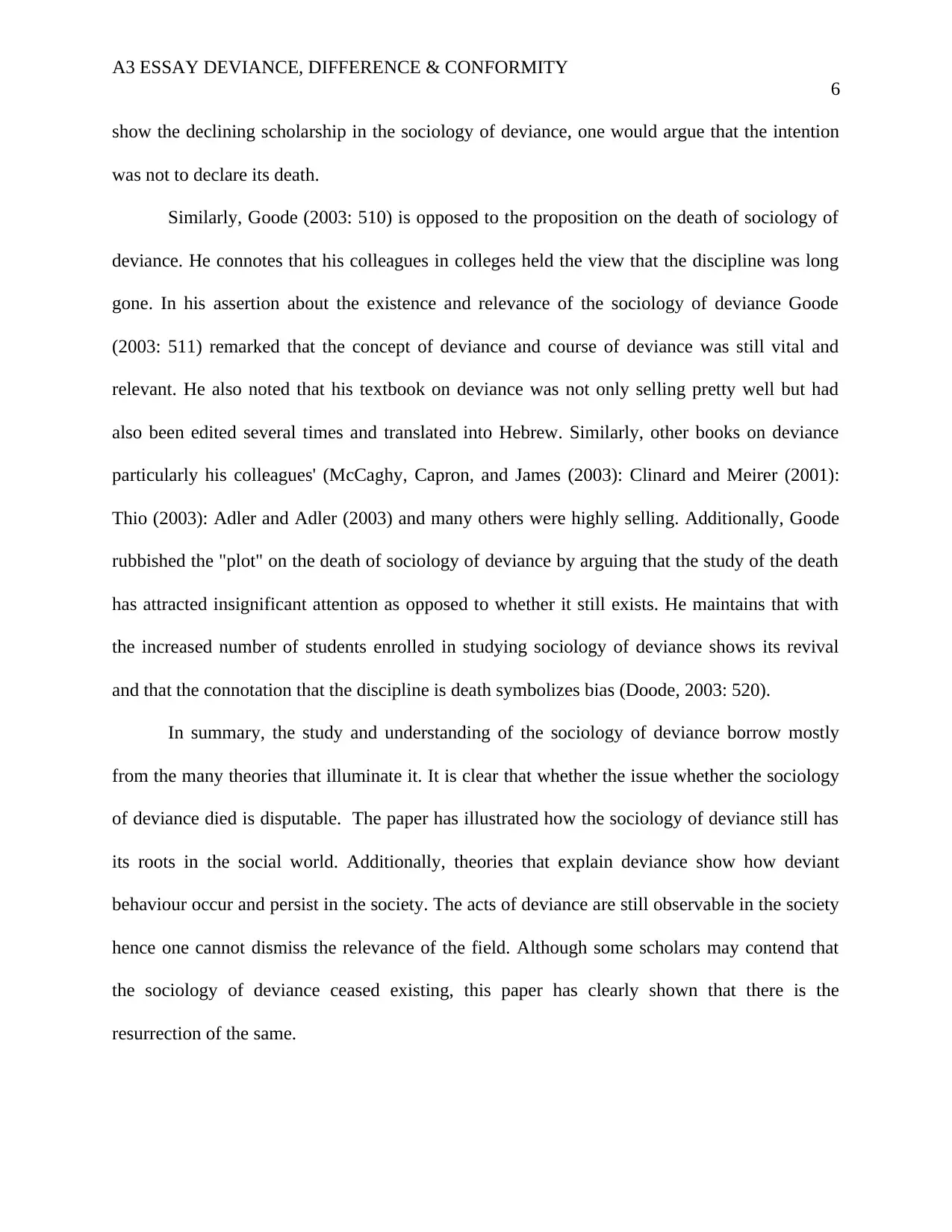
A3 ESSAY DEVIANCE, DIFFERENCE & CONFORMITY
6
show the declining scholarship in the sociology of deviance, one would argue that the intention
was not to declare its death.
Similarly, Goode (2003: 510) is opposed to the proposition on the death of sociology of
deviance. He connotes that his colleagues in colleges held the view that the discipline was long
gone. In his assertion about the existence and relevance of the sociology of deviance Goode
(2003: 511) remarked that the concept of deviance and course of deviance was still vital and
relevant. He also noted that his textbook on deviance was not only selling pretty well but had
also been edited several times and translated into Hebrew. Similarly, other books on deviance
particularly his colleagues' (McCaghy, Capron, and James (2003): Clinard and Meirer (2001):
Thio (2003): Adler and Adler (2003) and many others were highly selling. Additionally, Goode
rubbished the "plot" on the death of sociology of deviance by arguing that the study of the death
has attracted insignificant attention as opposed to whether it still exists. He maintains that with
the increased number of students enrolled in studying sociology of deviance shows its revival
and that the connotation that the discipline is death symbolizes bias (Doode, 2003: 520).
In summary, the study and understanding of the sociology of deviance borrow mostly
from the many theories that illuminate it. It is clear that whether the issue whether the sociology
of deviance died is disputable. The paper has illustrated how the sociology of deviance still has
its roots in the social world. Additionally, theories that explain deviance show how deviant
behaviour occur and persist in the society. The acts of deviance are still observable in the society
hence one cannot dismiss the relevance of the field. Although some scholars may contend that
the sociology of deviance ceased existing, this paper has clearly shown that there is the
resurrection of the same.
6
show the declining scholarship in the sociology of deviance, one would argue that the intention
was not to declare its death.
Similarly, Goode (2003: 510) is opposed to the proposition on the death of sociology of
deviance. He connotes that his colleagues in colleges held the view that the discipline was long
gone. In his assertion about the existence and relevance of the sociology of deviance Goode
(2003: 511) remarked that the concept of deviance and course of deviance was still vital and
relevant. He also noted that his textbook on deviance was not only selling pretty well but had
also been edited several times and translated into Hebrew. Similarly, other books on deviance
particularly his colleagues' (McCaghy, Capron, and James (2003): Clinard and Meirer (2001):
Thio (2003): Adler and Adler (2003) and many others were highly selling. Additionally, Goode
rubbished the "plot" on the death of sociology of deviance by arguing that the study of the death
has attracted insignificant attention as opposed to whether it still exists. He maintains that with
the increased number of students enrolled in studying sociology of deviance shows its revival
and that the connotation that the discipline is death symbolizes bias (Doode, 2003: 520).
In summary, the study and understanding of the sociology of deviance borrow mostly
from the many theories that illuminate it. It is clear that whether the issue whether the sociology
of deviance died is disputable. The paper has illustrated how the sociology of deviance still has
its roots in the social world. Additionally, theories that explain deviance show how deviant
behaviour occur and persist in the society. The acts of deviance are still observable in the society
hence one cannot dismiss the relevance of the field. Although some scholars may contend that
the sociology of deviance ceased existing, this paper has clearly shown that there is the
resurrection of the same.
⊘ This is a preview!⊘
Do you want full access?
Subscribe today to unlock all pages.

Trusted by 1+ million students worldwide
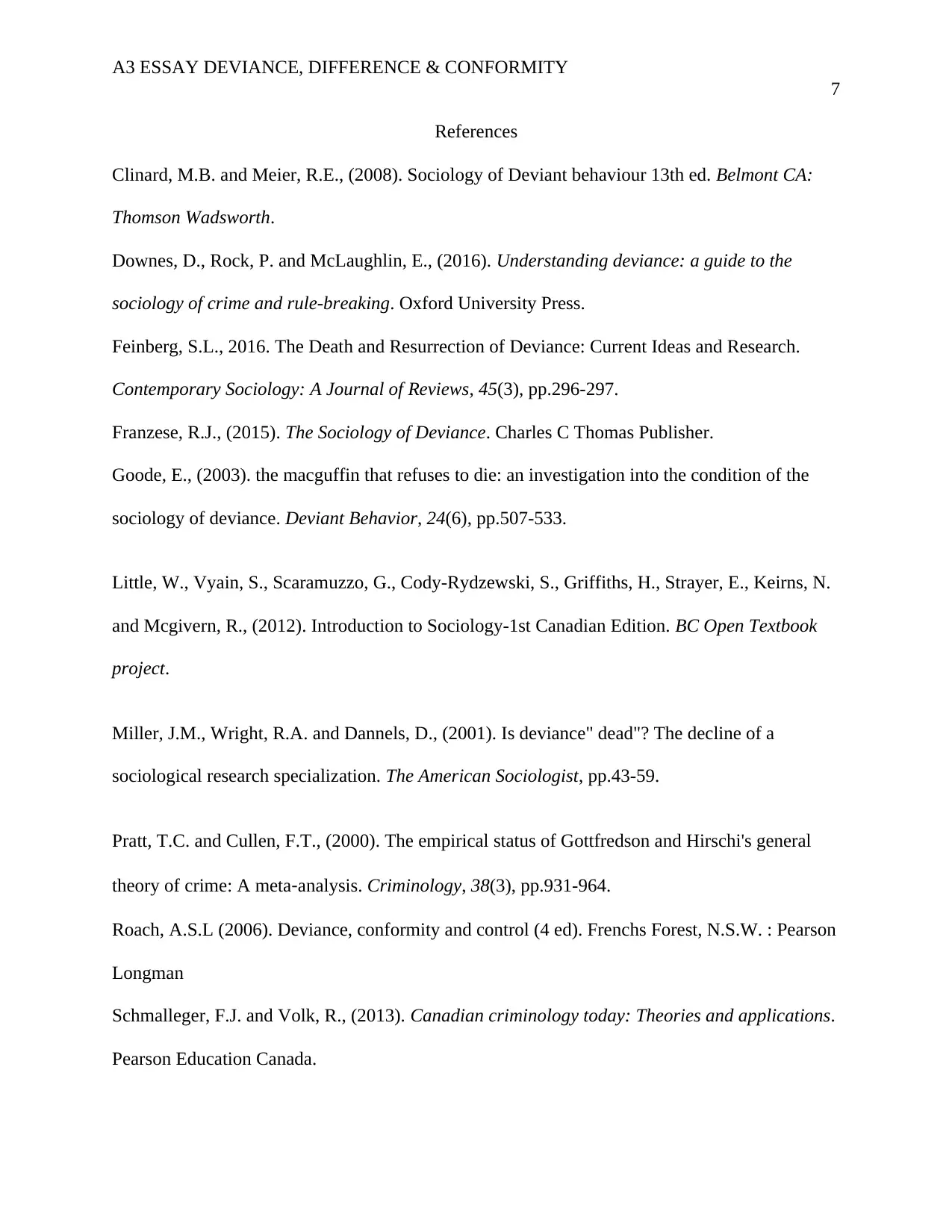
A3 ESSAY DEVIANCE, DIFFERENCE & CONFORMITY
7
References
Clinard, M.B. and Meier, R.E., (2008). Sociology of Deviant behaviour 13th ed. Belmont CA:
Thomson Wadsworth.
Downes, D., Rock, P. and McLaughlin, E., (2016). Understanding deviance: a guide to the
sociology of crime and rule-breaking. Oxford University Press.
Feinberg, S.L., 2016. The Death and Resurrection of Deviance: Current Ideas and Research.
Contemporary Sociology: A Journal of Reviews, 45(3), pp.296-297.
Franzese, R.J., (2015). The Sociology of Deviance. Charles C Thomas Publisher.
Goode, E., (2003). the macguffin that refuses to die: an investigation into the condition of the
sociology of deviance. Deviant Behavior, 24(6), pp.507-533.
Little, W., Vyain, S., Scaramuzzo, G., Cody-Rydzewski, S., Griffiths, H., Strayer, E., Keirns, N.
and Mcgivern, R., (2012). Introduction to Sociology-1st Canadian Edition. BC Open Textbook
project.
Miller, J.M., Wright, R.A. and Dannels, D., (2001). Is deviance" dead"? The decline of a
sociological research specialization. The American Sociologist, pp.43-59.
Pratt, T.C. and Cullen, F.T., (2000). The empirical status of Gottfredson and Hirschi's general
theory of crime: A meta‐analysis. Criminology, 38(3), pp.931-964.
Roach, A.S.L (2006). Deviance, conformity and control (4 ed). Frenchs Forest, N.S.W. : Pearson
Longman
Schmalleger, F.J. and Volk, R., (2013). Canadian criminology today: Theories and applications.
Pearson Education Canada.
7
References
Clinard, M.B. and Meier, R.E., (2008). Sociology of Deviant behaviour 13th ed. Belmont CA:
Thomson Wadsworth.
Downes, D., Rock, P. and McLaughlin, E., (2016). Understanding deviance: a guide to the
sociology of crime and rule-breaking. Oxford University Press.
Feinberg, S.L., 2016. The Death and Resurrection of Deviance: Current Ideas and Research.
Contemporary Sociology: A Journal of Reviews, 45(3), pp.296-297.
Franzese, R.J., (2015). The Sociology of Deviance. Charles C Thomas Publisher.
Goode, E., (2003). the macguffin that refuses to die: an investigation into the condition of the
sociology of deviance. Deviant Behavior, 24(6), pp.507-533.
Little, W., Vyain, S., Scaramuzzo, G., Cody-Rydzewski, S., Griffiths, H., Strayer, E., Keirns, N.
and Mcgivern, R., (2012). Introduction to Sociology-1st Canadian Edition. BC Open Textbook
project.
Miller, J.M., Wright, R.A. and Dannels, D., (2001). Is deviance" dead"? The decline of a
sociological research specialization. The American Sociologist, pp.43-59.
Pratt, T.C. and Cullen, F.T., (2000). The empirical status of Gottfredson and Hirschi's general
theory of crime: A meta‐analysis. Criminology, 38(3), pp.931-964.
Roach, A.S.L (2006). Deviance, conformity and control (4 ed). Frenchs Forest, N.S.W. : Pearson
Longman
Schmalleger, F.J. and Volk, R., (2013). Canadian criminology today: Theories and applications.
Pearson Education Canada.
Paraphrase This Document
Need a fresh take? Get an instant paraphrase of this document with our AI Paraphraser
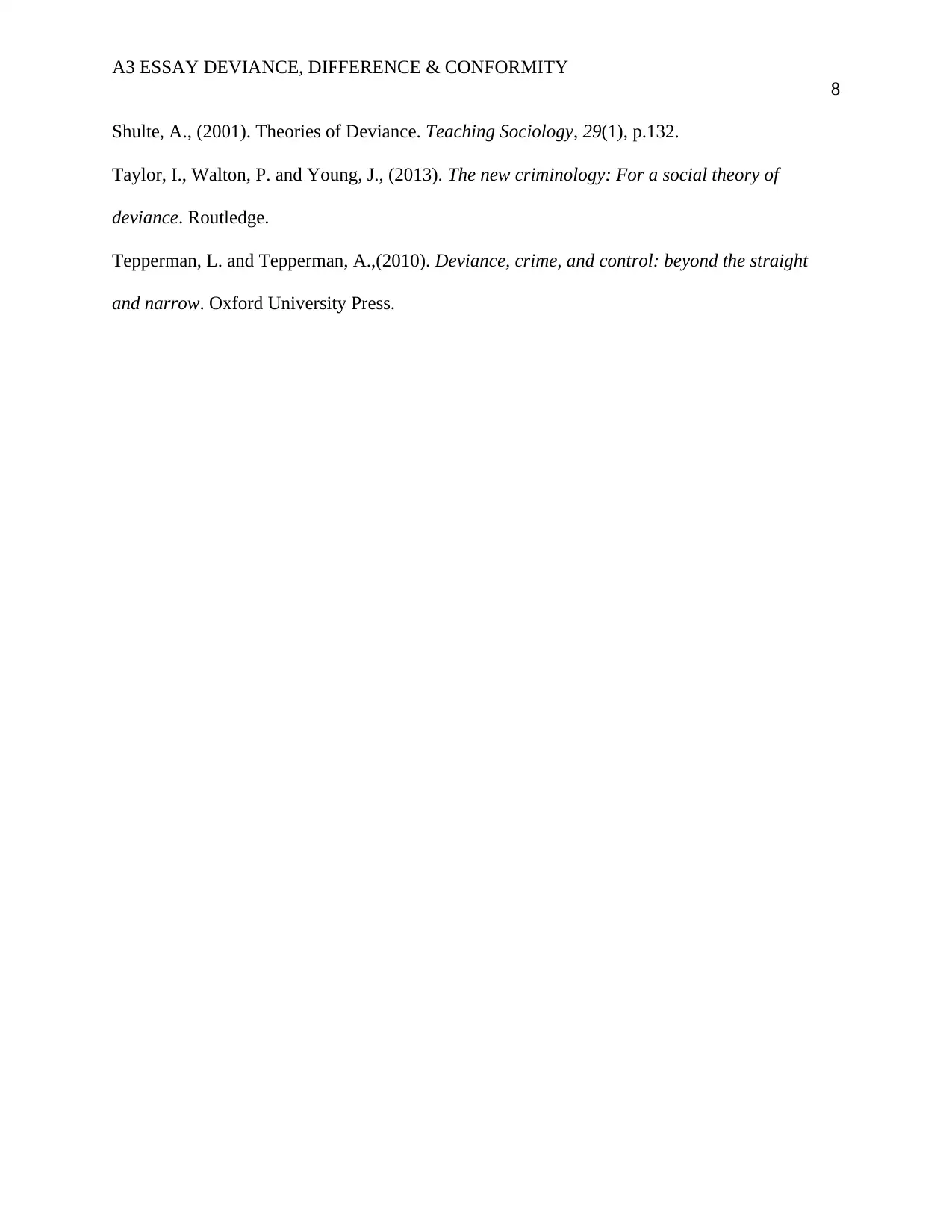
A3 ESSAY DEVIANCE, DIFFERENCE & CONFORMITY
8
Shulte, A., (2001). Theories of Deviance. Teaching Sociology, 29(1), p.132.
Taylor, I., Walton, P. and Young, J., (2013). The new criminology: For a social theory of
deviance. Routledge.
Tepperman, L. and Tepperman, A.,(2010). Deviance, crime, and control: beyond the straight
and narrow. Oxford University Press.
8
Shulte, A., (2001). Theories of Deviance. Teaching Sociology, 29(1), p.132.
Taylor, I., Walton, P. and Young, J., (2013). The new criminology: For a social theory of
deviance. Routledge.
Tepperman, L. and Tepperman, A.,(2010). Deviance, crime, and control: beyond the straight
and narrow. Oxford University Press.
1 out of 8
Related Documents
Your All-in-One AI-Powered Toolkit for Academic Success.
+13062052269
info@desklib.com
Available 24*7 on WhatsApp / Email
![[object Object]](/_next/static/media/star-bottom.7253800d.svg)
Unlock your academic potential
Copyright © 2020–2025 A2Z Services. All Rights Reserved. Developed and managed by ZUCOL.




